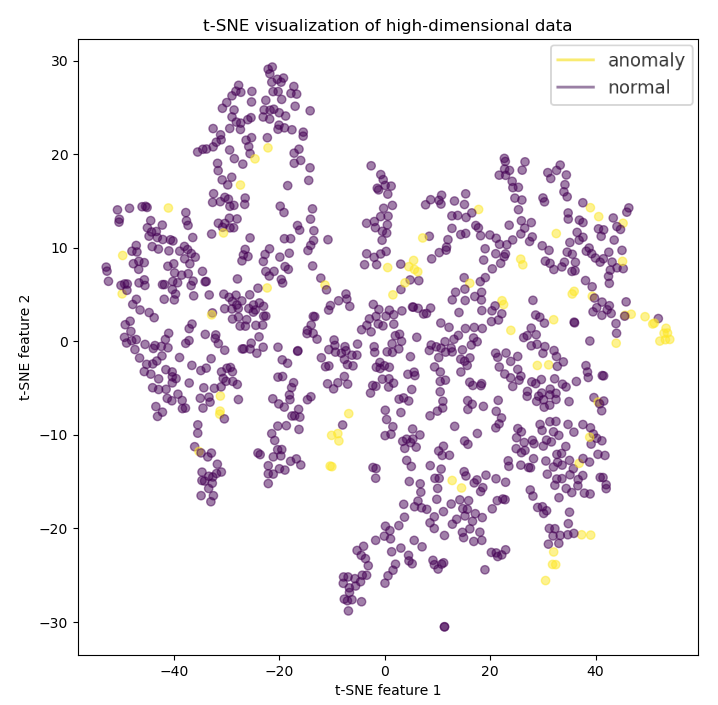Semi-supervised Anomaly Detection via Adaptive Reinforcement Learning-Enabled Method with Causal Inference

0

Sign in to get full access
Overview
- This paper proposes a semi-supervised anomaly detection method that uses adaptive reinforcement learning and causal inference.
- The method aims to improve anomaly detection performance by leveraging a small amount of labeled data along with a larger unlabeled dataset.
- The method adaptively adjusts the anomaly detection model based on feedback from a reinforcement learning agent.
- Causal inference is used to uncover relationships between features and the target anomaly label.
Plain English Explanation
The researchers have developed a new way to detect anomalies, or unusual patterns, in data. Their method uses a combination of semi-supervised learning, reinforcement learning, and causal inference.
The key idea is to start with a small amount of labeled data, which means some examples have been identified as normal or anomalous. The method then uses this information to learn an initial anomaly detection model. However, instead of just using this fixed model, the researchers employ a reinforcement learning agent that can adaptively adjust the model based on feedback.
The reinforcement learning agent tries different modifications to the anomaly detection model and observes whether these changes improve the detection of known anomalies in the labeled data. Over time, the agent learns which adjustments are most effective and continuously refines the model.
Additionally, the method uses causal inference to understand the relationships between the data features and the anomaly labels. This helps identify the most important factors contributing to anomalies, which can provide valuable insights.
By combining semi-supervised learning, reinforcement learning, and causal inference, the researchers aim to create an anomaly detection system that can effectively leverage limited labeled data and adapt to new patterns in the unlabeled data.
Technical Explanation
The paper proposes a semi-supervised anomaly detection method that utilizes adaptive reinforcement learning and causal inference.
The method starts by training an initial anomaly detection model using a small labeled dataset. A reinforcement learning agent is then employed to adaptively adjust this model based on feedback from the labeled data. The agent explores different modifications to the model and observes the impact on anomaly detection performance. Over time, the agent learns which adjustments are most effective and continuously refines the model.
Causal inference is used to uncover the relationships between the data features and the anomaly labels. This helps identify the most important factors contributing to anomalies, which can provide valuable insights and potentially improve the anomaly detection model.
The researchers evaluate their method on several benchmark anomaly detection datasets and compare its performance to other state-of-the-art approaches. The results demonstrate that the proposed semi-supervised, reinforcement learning-enabled method with causal inference can outperform traditional anomaly detection techniques, especially when only a limited amount of labeled data is available.
Critical Analysis
The paper presents a novel and promising approach to semi-supervised anomaly detection. The key strengths of the method include its ability to adaptively refine the anomaly detection model through reinforcement learning, and its use of causal inference to uncover important feature-anomaly relationships.
However, the paper does not fully address the potential limitations and caveats of the proposed method. For example, the impact of the initial labeled dataset size on the method's performance is not extensively explored. Additionally, the paper does not discuss the computational complexity of the reinforcement learning-based model updates, which could be a concern for real-time applications.
Further research could investigate the method's robustness to different types of anomalies, its scalability to large-scale datasets, and its applicability in diverse domains beyond the benchmarks used in the current study. Exploring ways to integrate domain-specific knowledge or explore semi-supervised anomaly detection in a more interactive, user-guided manner could also be fruitful avenues for future work.
Conclusion
This paper presents a novel semi-supervised anomaly detection approach that combines adaptive reinforcement learning and causal inference. By leveraging a small amount of labeled data and a larger unlabeled dataset, the method can effectively learn and refine an anomaly detection model.
The key innovations include the use of a reinforcement learning agent to adaptively adjust the model based on feedback, and the application of causal inference to uncover important feature-anomaly relationships. The results demonstrate the potential of this approach to outperform traditional anomaly detection techniques, especially in settings with limited labeled data.
While the paper has some limitations, it represents an important step forward in developing more robust and adaptive anomaly detection systems. Further research in this direction could lead to significant advancements in the field and enable the effective detection of anomalies in a wide range of real-world applications.
This summary was produced with help from an AI and may contain inaccuracies - check out the links to read the original source documents!
Related Papers


0
Semi-supervised Anomaly Detection via Adaptive Reinforcement Learning-Enabled Method with Causal Inference
Xiangwei Chen, Ruliang Xiaoa, Zhixia Zeng, Zhipeng Qiu, Shi Zhang, Xin Du
Semi-supervised anomaly detection for sensor signals is critical in ensuring system reliability in smart manufacturing. However, existing methods rely heavily on data correlation, neglecting causality and leading to potential misinterpretations due to confounding factors. Moreover, while current reinforcement learning-based methods can effectively identify known and unknown anomalies with limited labeled samples, these methods still face several challenges, such as under-utilization of priori knowledge, lack of model flexibility, and deficient reward feedback during environmental interactions. To address the above problems, this paper innovatively constructs a counterfactual causal reinforcement learning model, termed Triple-Assisted Causal Reinforcement Learning Anomaly Detector (Tri-CRLAD). The model leverages causal inference to extract the intrinsic causal feature in data, enhancing the agent's utilization of prior knowledge and improving its generalization capability. In addition, Tri-CRLAD features a triple decision support mechanism, including a sampling strategy based on historical similarity, an adaptive threshold smoothing adjustment strategy, and an adaptive decision reward mechanism. These mechanisms further enhance the flexibility and generalization ability of the model, enabling it to effectively respond to various complex and dynamically changing environments. Experimental results across seven diverse sensor signal datasets demonstrate that Tri-CRLAD outperforms nine state-of-the-art baseline methods. Notably, Tri-CRLAD achieves up to a 23% improvement in anomaly detection stability with minimal known anomaly samples, highlighting its potential in semi-supervised anomaly detection scenarios. Our code is available at https://github.com/Aoudsung/Tri-CRLAD.
Read more5/17/2024


0
Self-Supervised Time-Series Anomaly Detection Using Learnable Data Augmentation
Kukjin Choi, Jihun Yi, Jisoo Mok, Sungroh Yoon
Continuous efforts are being made to advance anomaly detection in various manufacturing processes to increase the productivity and safety of industrial sites. Deep learning replaced rule-based methods and recently emerged as a promising method for anomaly detection in diverse industries. However, in the real world, the scarcity of abnormal data and difficulties in obtaining labeled data create limitations in the training of detection models. In this study, we addressed these shortcomings by proposing a learnable data augmentation-based time-series anomaly detection (LATAD) technique that is trained in a self-supervised manner. LATAD extracts discriminative features from time-series data through contrastive learning. At the same time, learnable data augmentation produces challenging negative samples to enhance learning efficiency. We measured anomaly scores of the proposed technique based on latent feature similarities. As per the results, LATAD exhibited comparable or improved performance to the state-of-the-art anomaly detection assessments on several benchmark datasets and provided a gradient-based diagnosis technique to help identify root causes.
Read more6/28/2024


0
Explainable Online Unsupervised Anomaly Detection for Cyber-Physical Systems via Causal Discovery from Time Series
Daniele Meli
Online unsupervised detection of anomalies is crucial to guarantee the correct operation of cyber-physical systems and the safety of humans interacting with them. State-of-the-art approaches based on deep learning via neural networks achieve outstanding performance at anomaly recognition, evaluating the discrepancy between a normal model of the system (with no anomalies) and the real-time stream of sensor time series. However, large training data and time are typically required, and explainability is still a challenge to identify the root of the anomaly and implement predictive maintainance. In this paper, we use causal discovery to learn a normal causal graph of the system, and we evaluate the persistency of causal links during real-time acquisition of sensor data to promptly detect anomalies. On two benchmark anomaly detection datasets, we show that our method has higher training efficiency, outperforms the accuracy of state-of-the-art neural architectures and correctly identifies the sources of >10 different anomalies. The code is at https://github.com/Isla-lab/causal_anomaly_detection.
Read more7/30/2024


0
Multi-agent Reinforcement Learning-based Network Intrusion Detection System
Amine Tellache, Amdjed Mokhtari, Abdelaziz Amara Korba, Yacine Ghamri-Doudane
Intrusion Detection Systems (IDS) play a crucial role in ensuring the security of computer networks. Machine learning has emerged as a popular approach for intrusion detection due to its ability to analyze and detect patterns in large volumes of data. However, current ML-based IDS solutions often struggle to keep pace with the ever-changing nature of attack patterns and the emergence of new attack types. Additionally, these solutions face challenges related to class imbalance, where the number of instances belonging to different classes (normal and intrusions) is significantly imbalanced, which hinders their ability to effectively detect minor classes. In this paper, we propose a novel multi-agent reinforcement learning (RL) architecture, enabling automatic, efficient, and robust network intrusion detection. To enhance the capabilities of the proposed model, we have improved the DQN algorithm by implementing the weighted mean square loss function and employing cost-sensitive learning techniques. Our solution introduces a resilient architecture designed to accommodate the addition of new attacks and effectively adapt to changes in existing attack patterns. Experimental results realized using CIC-IDS-2017 dataset, demonstrate that our approach can effectively handle the class imbalance problem and provide a fine grained classification of attacks with a very low false positive rate. In comparison to the current state-of-the-art works, our solution demonstrates a significant superiority in both detection rate and false positive rate.
Read more7/9/2024